
Table of Contents
Tongue piercings, once a bold statement reserved for the most daring among us, have steadily woven their way into mainstream fashion and culture. But beyond their edgy appeal, there’s a world of information to uncover—from the piercing process to the intricate aftercare.
Whether you’re considering joining the ranks of tongue-pierced individuals or just curious about the trend, let’s explore what makes this particular body modification both intriguing and popular.
What is the Tongue Piercing?

A tongue piercing involves making a hole in the tongue’s center to fit jewelry, often a barbell. It can sit near the tongue’s tip or its middle. Many young people love this piercing for its self-expression. Instead of piercing the skin like most, you pierce a muscle in the tongue, making its care and healing unique.
Although it looks modern, ancient civilizations first used it for spiritual and cultural reasons. Today, people choose it for its look and the bold statement it offers.
Origin and History of Tongue Piercings
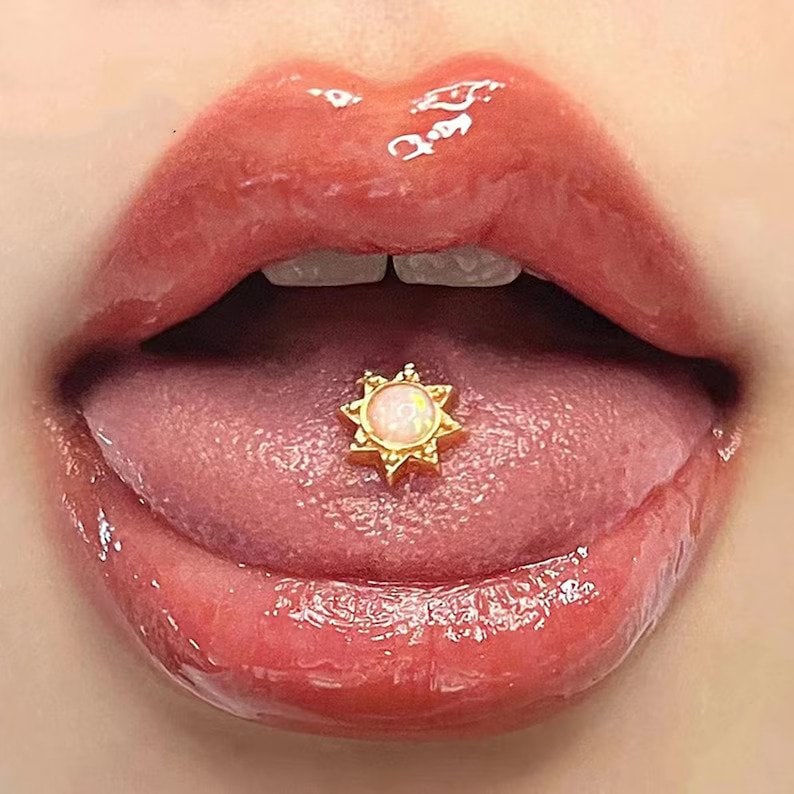
Tongue piercings, commonly seen as modern self-expression, actually have roots in ancient times. Well before 90s celebrities showcased them, the Mesoamericans and Aztecs used them in religious and performance rituals.
These cultures deeply valued the spiritual and cultural significance of piercing the tongue, highlighting it as an early form of body modification. In the 1980s, people began adopting tongue piercings as personal jewelry. But the real surge in its popularity came in the 1990s, largely because of Jim Ward.
Jim Ward played a pivotal role in popularizing tongue piercings and other body modifications in the U.S.A. Before he set up the first professional body piercing studio, people mostly got these modifications in underground or less-regulated places. This lack of regulation often made piercings riskier and harder to access.
But Ward changed that by opening a studio that valued safety, cleanliness, and professionalism. As more and more people visited his studio and shared their positive experiences, the demand for tongue piercings and other body modifications skyrocketed.
Ward didn’t stop at just offering piercings. He also trained new piercers, making sure they knew the best and safest methods. This training led to the opening of more professional studios around the country, all keeping up with the standards Ward introduced.
Thanks to Ward’s efforts in the 1980s and 1990s, tongue piercings’ popularity soared in the 2000s. Famous personalities showcased their tongue piercings, bringing them even more into the limelight. As society became more accepting, we saw innovative jewelry designs and new piercing techniques, giving people more options to express themselves.
Types of Tongue Piercings
If you’re a beginner, the traditional piercing is the most suitable option but if you’re an experienced ‘piercee’ looking for something different, there are several variations you can opt for. Let’s have a look at the different types of tongue piercings out there!
1. Midline Tongue Piercing
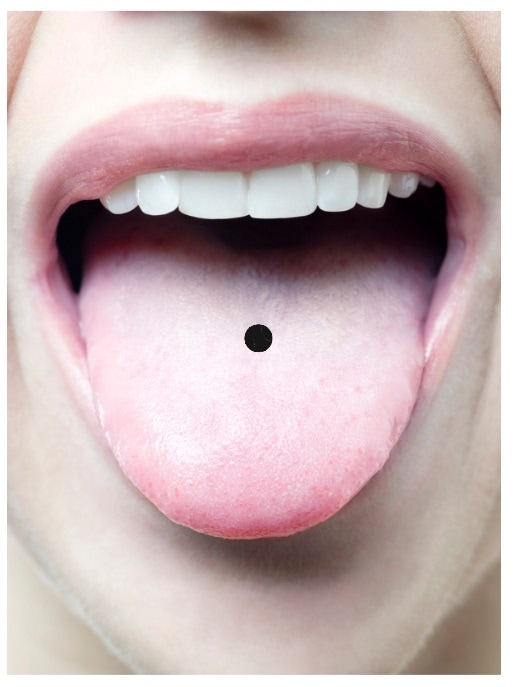
This is the traditional tongue piercing which involves a single vertical perforation right in the center of the tongue. It’s the simplest of all tongue piercings, making it the perfect choice for a first-timer. It’s quite painless as the tongue is pierced through the middle, where there are fewer nerves, and it’s more affordable than other piercings due to its simplicity.
2. Tongue Web Piercing
This piercing is perfect since it’s located under the tongue and is an ideal hidden piercing. It’s a special piercing in which the perforation is done through the frenulum (the under-tongue webbing) located just between your tongue and the floor of your mouth.
However, this isn’t a typical tongue piercing and doesn’t work for everyone as it requires a thicker frenulum to fix the jewelry through. If yours is fairly thin, you should probably avoid getting this.
3. Snake Eyes Tongue Piercing
This rare and unusual piercing gets its name from its resemblance to the eyes of a snake. It’s located on the tip of the tongue and is formed by a single piece of jewelry going through the tip of the tongue horizontally.
The downside of this piercing is that it can eventually migrate, leaving scars on your tongue so you might want to consider this risk before you go ahead.
4. Venom Bites Piercing
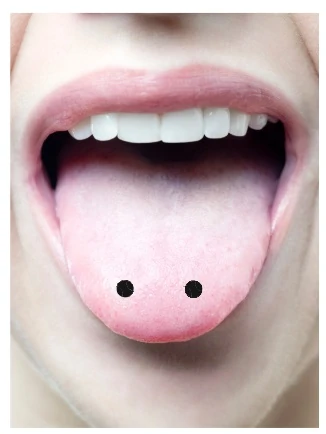
This is a double tongue piercing placed side by side and located symmetrically on either side of the tongue, resembling venom bites or the eyes of a frog. Although this piercing can look scary, it’s also unique, stylish and guaranteed to make you stand out in the crowd.
However, as it involves a double perforation, it would require a lot more care than a single perforation so that infections and unwanted complications can be avoided.
5. Frowny Tongue Piercing
The Frowny piercing is similar to the tongue web piercing as it also goes through the frenulum under the tongue. The difference, however, is that it’s done between the lower gum and the lip. It’s easy to hide anytime you need to for work and formal occasions.
The downside is that like all frenulum piercings, this one too is prone to migration so if you’re looking for something more long term it may not be the best choice.
6. Surface Scoop Piercing
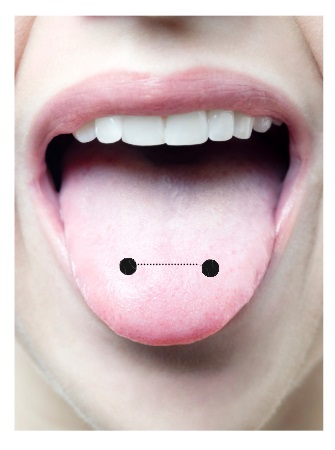
The Surface Scoop piercing is located on the surface of the tongue, making it one of the less painful piercings as it goes through less tongue tissue than the others. It can be done across the surface or lengthwise along the tongue but because it’s just on the surface, there’s a high risk of jewelry rejection and migration.
7. Multiple or Double Tongue Piercing
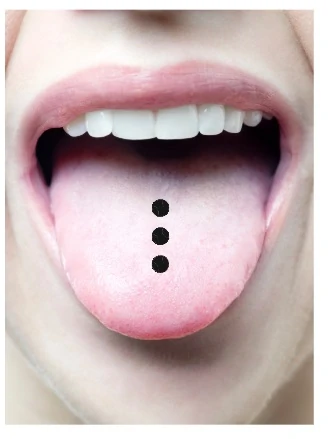
If you’re a piercing enthusiast, this could be the perfect piercing for you. A set of two or more separated perforations made up of multiple piercings is what this piercing is all about. You can play around with not only the variations but also the jewelry as multiple piercings will allow you to insert different types of jewelry.
Having multiple tongue piercings requires a lot more attention and care. Our recommendation? Start with one and then work your way upwards.
How is the Tongue Piercing Done?
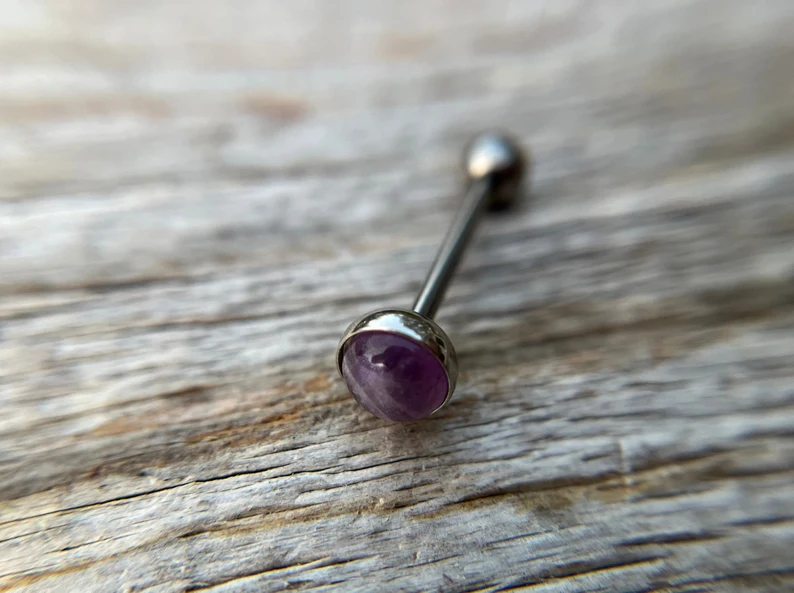
If you’re thinking about getting a tongue piercing, here’s how the process typically goes. First, a professional piercer checks your tongue’s shape and size to see if it’s right for the piercing. Once they approve, they clean your tongue thoroughly.
Then, they use a safe marker to pinpoint where the piercing will go, making sure it’s in the right spot. Before starting, you’ll usually rinse your mouth with a special mouthwash. To make sure the piercing is precise, the piercer clamps your tongue in place.
Next, they pierce the marked spot with a clean, hollow needle and insert the chosen jewelry, often a barbell. The whole thing doesn’t take too long, but the piercer’s skill is crucial for a smooth experience. After you’re pierced, they’ll give you guidelines to care for it, helping it heal properly and stay infection-free.
What are the Best Types of Jewelry for Tongue Piercings?
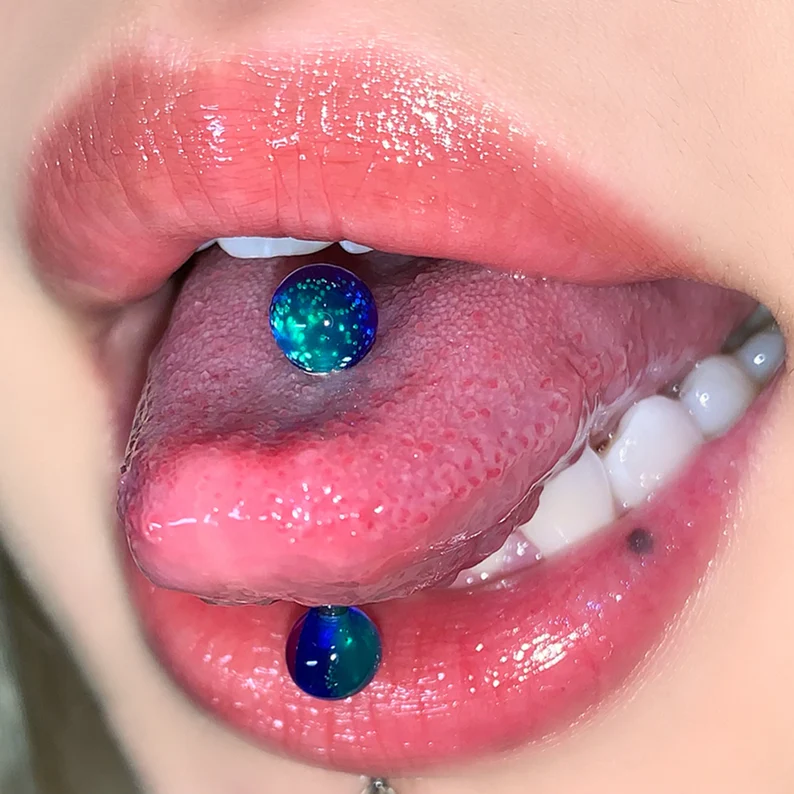
Choosing the right jewelry for tongue piercings is important for your comfort, safety, and style. Many piercers recommend the straight barbell for new tongue piercings. This barbell has a straight bar with a ball on each end, and it works well because it gives room for the common swelling after getting pierced.
When picking the material for your jewelry, consider surgical stainless steel, titanium, or niobium. These materials are popular choices for new piercings because they don’t cause allergic reactions, helping your piercing heal smoothly. You can also choose gold, but make sure it’s real 14k or 18k gold. Avoid gold-plated jewelry since the plating can wear off and reveal the metal underneath.
The barbell’s length and thickness matter too. At first, piercers often use a longer bar to deal with swelling. But once your piercing heals, you might want a shorter barbell for a better fit. Most tongue piercings use a 14G gauge for thickness.
While many people like the classic ball ends on their barbells, you have other options too. From gemstones to special shapes, you can pick ends that show off your style. Just make sure you pick ends that are smooth and securely attached so you don’t risk any issues with your teeth or mouth.
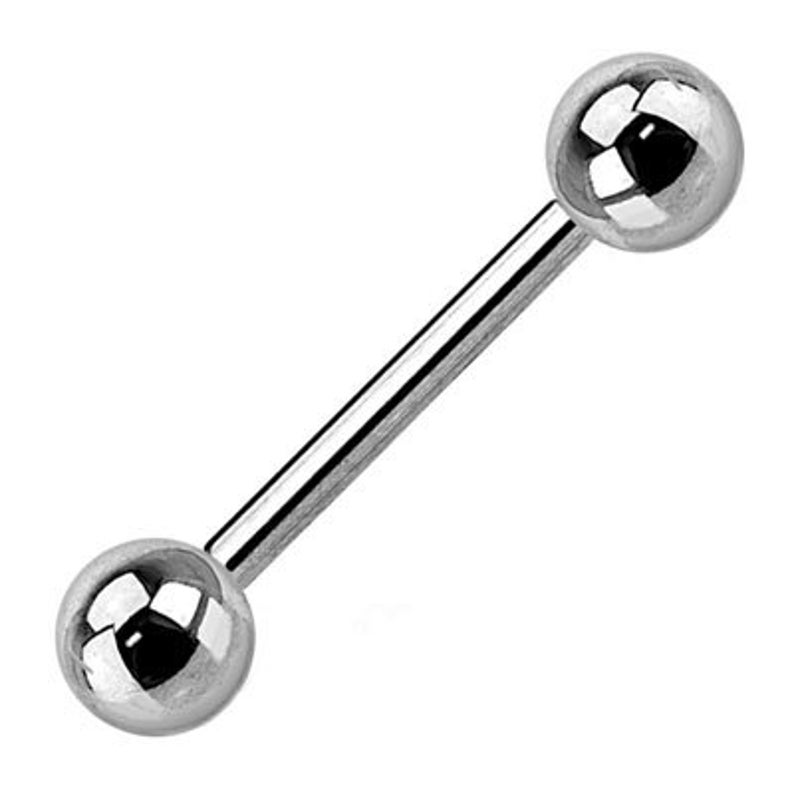
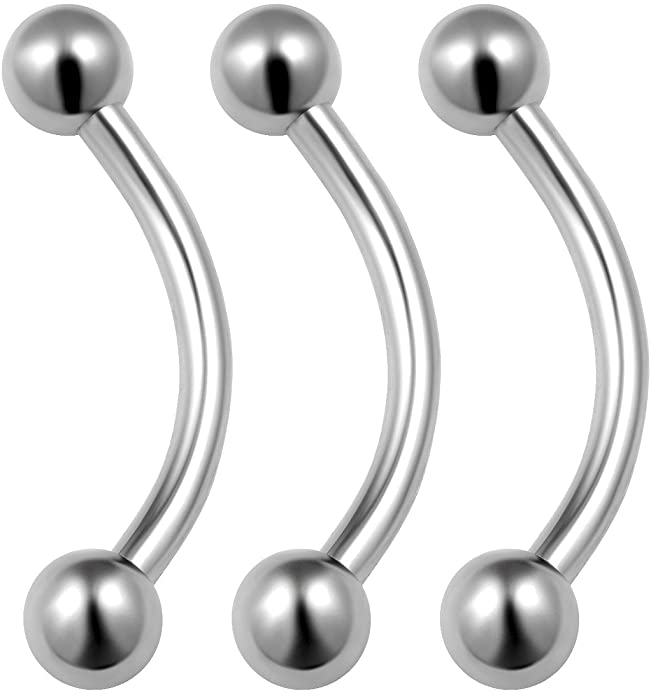
Tongue Piercing Pain and Aftercare

The tongue piercing is one of the least painful piercings (usually ranked 3-4 on the pain scale) but the level of pain actually depends on the person. Pain is subjective and everyone’s pain threshold is different.
However, it would be safe to say that yes, you will probably feel a little sting but it won’t be a lot more than that. Many people claim that it hurt a lot less than they expected so try not to worry too much. It’s actually during the healing phase that you will feel more pain.
Luckily, tongues heal amazingly fast but following the golden rules of aftercare will help it heal even faster. With proper care, healing will take about 1-4 weeks. Here are some aftercare tips to help speed up the process and avoid complications.
- Rinse your mouth out after every meal – do this using an alcohol-free antibacterial or antimicrobial mouth rinse for about one minute after every meal.
- Wash your hands thoroughly before touching your piercing – this is vital to minimize bacteria and the risk of getting an infection.
- Replace your toothbrush regularly – don’t use the same toothbrush for extended periods of time after you get your piercing done since it can be a breeding ground for bacteria.
- Clean the piercing twice a day – rinse twice a day with saline to help the piercingheal faster and to further reduce the chance of getting an infection.
- Avoid spicy foods and hot drinks – it will be difficult to eat certain food or drink hot beverages for a few days after you get your piercing done. Avoid these for the first few days as they can irritate your piercing and interfere with the healing process.
- Avoid playing with the jewelry – try to minimize movement and leave your piercing alone as much as movement. Don’t keep touching your jewelry or moving it around with your tongue as movement will interfere with the healing.
- Make sure the ends of your jewelry are tightly fitted on – the last thing you’d want is for your jewelry to get loose and end up in your stomach. Tighten the ends so there won’t be any chance of you choking on your jewelry.
With proper aftercare your piercing should heal in no time at all. Keep an eye open for signs of infection and if you experience any redness, pus oozing from the piercing, fever, pain or tenderness, get medical help immediately.
What are the Pros and Cons of the Tongue Piercing?
If you’re having trouble figuring out whether this is the right piercing for you, weighing the pros and cons might help you to decide.
Pros
- Tongue piercings heal faster than most other piercings.
- They are easy to hide – no one will notice it unless you show it off.
- It looks stylish yet subtle.
- There are many variations of the piercing to choose from.
Cons
- There is a high risk for jewelry rejection and migration.
- There is a risk of swallowing the jewelry if it gets loose.
- The mouth is home to hundreds of different types of bacteria so there is a higher risk of infection.
- It can pose serious health risks.
Tongue Piercing Meaning

While some believe that having a tongue piercing makes for an enhanced sexual experience, in reality, tongue piercings doesn’t add much to oral pleasure for both the wearer and the receiver. This misconception is also why sometimes there’s a stigma surrounding the tongue piercing.
Because the tongue piercing began as a religious practice, its historical connection for many tribes and people was connected to the spiritual and the holy. For the Aztecs and Mayans, tongue piercings had a more gruesome meaning. They were done as a blood sacrifice to the Gods.
Today, tongue piercings are mainly seen as a form of self-expression, closely associated with the reputation of being risky and courageous so if you really want one, there’s no reason why you shouldn’t get it.
Wrapping Up
Tongue piercings combine old traditions with today’s style. Picking the right jewelry and following proper aftercare matters a lot, but it’s the personal statement that stands out. Remember to always keep safety and style at the forefront.









